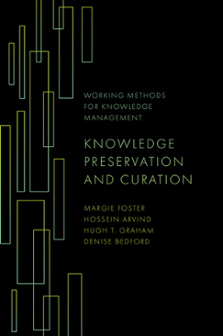
Index
Knowledge Preservation and Curation
ISBN: 978-1-83982-931-4, eISBN: 978-1-83982-930-7
Publication date: 1 December 2023
Citation
Foster, M., Arvand, H., Graham, H.T. and Bedford, D. (2023), "Index", Knowledge Preservation and Curation (Working Methods for Knowledge Management), Emerald Publishing Limited, Leeds, pp. 203-208. https://doi.org/10.1108/978-1-83982-930-720231011
Publisher
:Emerald Publishing Limited
Copyright © 2024 Margie Foster, Hossein Arvand, Hugh T. Graham and Denise Bedford
INDEX
- Prelims
- Knowledge Preservation – Current and Future Perspectives
- Chapter 1: Fundamentals of Preservation
- Chapter 2: Thinking Strategically About Knowledge Preservation and Curation
- Chapter 3: Future-proofing a Preservation and Curation Strategy
- Chapter 4: The Challenge of Channels to Preserving and Curating Knowledge Assets
- Curating Knowledge for Use
- Chapter 5: Curating Knowledge
- Chapter 6: Expanding Preservation and Curation to Knowledge Assets
- Chapter 7: Architectures and Infrastructures to Support Knowledge Curation
- Knowledge Curation Strategies, Capabilities, and Competencies
- Chapter 8: Knowledge Preservation and Curation Strategies
- Chapter 9: Knowledge Preservation and Curation Capabilities and Methods
- Chapter 10: Knowledge Preservation and Curation Roles, Responsibilities and Competencies
- Appendix 1: Pulling It All Together
- Appendix 2: Futuring Methods to Support Strategic Thinking
- Index